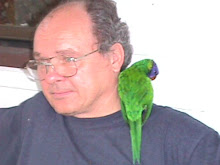
Here, Down Under, we’re starting the second week of 2010. It’s grey, overcast and considering this is our summer, cold. I’m sitting on the south veranda overlooking the larger of the bird tables. The Galahs [16] and Sulphur-crested Cockatoos [4] dominated a while ago but a Noisy Miner alarm call saw them scatter to be replaced by Apostlebirds [5] and the occasional Blue-faced Honeyeater. Somewhere off in the distance I can hear a Torresian Crow and a Grey Butcherbird.
Apostlebird

The first week was quite momentous for the Year List, especially in raptors. The current tally stands at 104.
We hit the track running with glorious views of a pair of White-bellied Sea-Eagles followed almost immediately by a pair of Pacific Baza. That in itself was a surprise. We tend to see them individually. At the Gibson State Forest we chanced upon a pair of Wedge-tailed Eagles feeding on a wallaby carcass and on the way home stumbled across a local ‘magatick’, the Australian Hobby [Falco longipennis].
On Monday, returning to work, Fay was compensated by views of the Peregrine Falcon that calls the peanut silos home. I’ll have to pop over to Kingaroy to add it to my list. On Wednesday we had to travel to the coast on business but managed to add Nankeen Kestrel and Black-shouldered Kite [the same critter that is now resident in southern Spain and dotted along the north African coastline].
It augers well for 2010. During 2009 we had Whistling Kite, Brown Goshawk and Collared Sparrowhawk nearby. In the last weeks of 2009 we had a Little Eagle hovering no more than a couple of metres above our heads and perhaps six metres away- and that was only six kilometres from our front gate! Also on the list, but rarer, are both the Brown and Black Falcon. We know of some fairly reliable sites for Osprey and Brahminy Kite. The Grey Goshawk is a regular occurrence in the Bunya Mountains, some 60km from here.
We already have 25% of Australia’s diurnal raptors; the potential to score 50% without travelling too far afield.
Black Swan in flight @ Brooklands Water Reserve

Current Tally [in alphabetical order based on main name]
Apostlebird
Babbler, Grey-crowned
Baza, Pacific
Bittern, Black
Bowerbird, Satin
Butcherbird, Grey
Butcherbird, Pied
Chough, White-winged
Cicadabird
Cockatoo, Sulphur-crested
Corella, Little
Cormorant, Little Black
Cormorant, Little Pied
Cormorant, Pied
Coucal, Pheasant
Crow, Torresian
Cuckoo, Black-eared
Cuckoo, Brush
Cuckoo, Channel-billed
Cuckoo, Fan-tailed
Cuckoo-Dove, Brown
Cuckoo-shrike, Black-faced
Cuckoo-shrike, Ground
Currawong, Pied
Dollarbird
Dove, Bar-shouldered
Dove, Peaceful
Dove, Spotted
Duck, Australian Wood
Duck, Pacific Black
Eagle, Wedge-tailed
Egret, Cattle
Egret, Eastern Great
Egret, Little
Fairy-wren, Red-backed
Fairy-wren, Superb
Fairy-wren, Variegated
Falcon, Peregrine
Fantail, Grey
Figbird, Australasian
Finch, Double-barred
Finch, Red-browed
Flycatcher, Restless
Friarbird, Little
Friarbird, Noisy
Frogmouth, Tawny
Galah
Gerygone, White-throated
Grebe, Australasian
Gull, Silver
Hardhead
Heron, White-faced
Heron, White-necked
Hobby, Australian
Honeyeater, Blue-faced
Honeyeater, Brown
Honeyeater, Lewin's
Honeyeater, Scarlet
Honeyeater, Striped
Honeyeater, Yellow-faced
Ibis, Australian White
Ibis, Straw-necked
Kestrel, Nankeen
Kingfisher, Sacred
King-Parrot, Australian
Kite, Black-shouldered
Koel, Eastern
Kookaburra, Laughing
Lapwing, Masked
Lorikeet, Rainbow
Magpie, Austarlian
Magpie-lark
Martin, Fairy
Martin, Tree
Miner, Noisy
Mistletoebird
Moorhen, Dusky
Myna, Common
Needletail, White-throated
Oriole, Olive-backed
Pardalote, Striated
Pigeon, Crested
Pigeon, Wonga
Pipit, Australasian
Quail, Brown
Reed-Warbler, Australian
Rosella, Pale-headed
Scrubwren, White-browed
Sea-eagle, White-bellied
Silvereye
Sparrow, House
Spoonbill, Yellow-billed
Stone-curlew, Bush
Swallow, Welcome
Swamphen, Purple
Swan, Black
Teal, Grey
Thornbill, Brown
Thornbill, Yellow
Wagtail, Willie
Whipbird, Eastern
Whistler, Rufous
Whistling-Duck, Plumed
Whistling-Duck, Wandering
TOP FIVE
1. Black Bittern
2. Australian Hobby
3. Black-eared Cuckoo
4. Ground Cuckoo-shrike
5. Pacific Baza

No comments:
Post a Comment